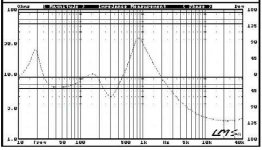Hello all,
I was wondering if a pair of LM4780/channel (internaly connected in parallel too) is able to drive an ESL panel.
What will be the ideal transformer (secondary voltage, amperes) for ''feeding'' such an amp?
Here is the impendance plot of the ESL panel to be driven.
Regards
P
I was wondering if a pair of LM4780/channel (internaly connected in parallel too) is able to drive an ESL panel.
What will be the ideal transformer (secondary voltage, amperes) for ''feeding'' such an amp?
Here is the impendance plot of the ESL panel to be driven.
Regards
P
Attachments
What will be the ideal transformer (secondary voltage, amperes) for ''feeding'' such an amp?
Here is the impendance plot of the ESL panel to be driven.
The impedance plot (if real) is obviously taken through a step-up transformer. The transformer ratio will be determined by the distance between the plates of the panel. Generally, the higher this ratio becomes, the more difficult the job of the amp.
Hello all,
Yes, the plot is true and is indeed taken throught a step up transformer with 1:100 turns ratio.
After some more carefull reading in the National LM4780 datasheet i found that it is recommended to parallel them to increase the current for driving difficult loads such us the ElectroStatic Loudspeakers (ESL).
If two LM4780/ch (four amps in Parallel mode) is going to be use to drive the ESL's 2 Ohm load it means that each amp is ''sees'' 8 ohm load which is Ok. Or it is better to use 3 x LM4780 in parallel?
I assume that 4 x LM4780/ch is an overkill?
Opinions?
Regards
P
The impedance plot (if real) is obviously taken through a step-up transformer.
Yes, the plot is true and is indeed taken throught a step up transformer with 1:100 turns ratio.
After some more carefull reading in the National LM4780 datasheet i found that it is recommended to parallel them to increase the current for driving difficult loads such us the ElectroStatic Loudspeakers (ESL).
If two LM4780/ch (four amps in Parallel mode) is going to be use to drive the ESL's 2 Ohm load it means that each amp is ''sees'' 8 ohm load which is Ok. Or it is better to use 3 x LM4780 in parallel?
I assume that 4 x LM4780/ch is an overkill?
Opinions?
Regards
P
4 of them would not be overkill since the lowest they can drive is a 4 ohm load. Maybe its just me but i still dont understand how the amp load is looked at. From what i remember in my electronics class, paralleing them would provide more current but each will see the same load. Each chip would still see 2ohms but having more would just mean it has less work to do. yes i have read the data sheets for the LM's but the finding the load seems wrong... (maybe im just confused then on the way the teacher put it in class) .
.
Are you going to use briangt's kits since the 4780's are already paralled on his pcb.. this means you could aslo try one amp paralled first then add the other in.
Are you going to use briangt's kits since the 4780's are already paralled on his pcb.. this means you could aslo try one amp paralled first then add the other in.
4 of them would not be overkill since the lowest they can drive is a 4 ohm load. Maybe its just me but i still dont understand how the amp load is looked at. From what i remember in my electronics class, paralleing them would provide more current but each will see the same load. Each chip would still see 2ohms but having more would just mean it has less work to do. yes i have read the data sheets for the LM's but the finding the load seems wrong... (maybe im just confused then on the way the teacher put it in class)
No, i think you are wrong.
If you look at the LM4780 datasheet (page 16) you will see the following equation, Rl(parallel)=Rl(total)*Number of Amplifiers
"When operating two or more amplifiers in parallel mode the impedance seen by each amplifier its equally to the total load impedance multiplied by the number of amplifiers that drives the load''
In other words, if 2xLM4780 (4 amplifiers) in parallel mode are going to drive a 2 ohm load each amplifier will ''see'' a 8 ohm load but can deliver 4 times more current.
Are you going to use briangt's kits since the 4780's are already paralled on his pcb.. this means you could aslo try one amp paralled first then add the other in.
Yes this what i'm going to use but starting at 2xLM4780.
Thoughts?
Regards
P
i am going to do samething like you are and i plan on getting the mono block versions. I like the idea of each amp having its own power instead of sharing... no ideas really just want to know how it sound when you get down...
I take it your going to put the amps in the same case or two different ones. Also have you given any thought on the heat sinks your going to use?
I take it your going to put the amps in the same case or two different ones. Also have you given any thought on the heat sinks your going to use?
- Status
- This old topic is closed. If you want to reopen this topic, contact a moderator using the "Report Post" button.
- Home
- Amplifiers
- Chip Amps
- 2 x LM4780 in parallel to drive ESL panel
